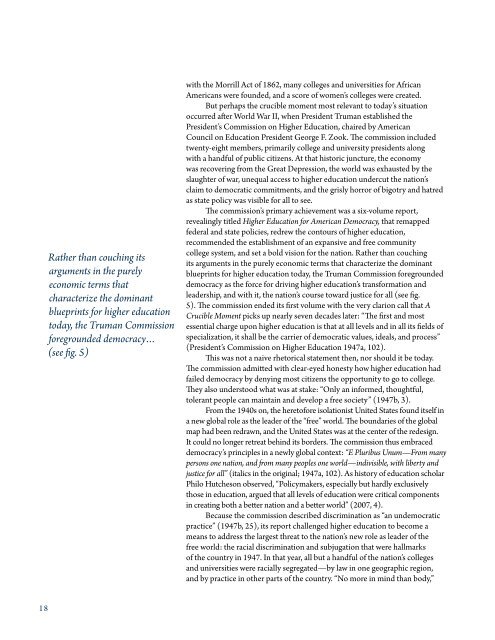MoMent
Crucible_508F
Crucible_508F
You also want an ePaper? Increase the reach of your titles
YUMPU automatically turns print PDFs into web optimized ePapers that Google loves.
Rather than couching its<br />
arguments in the purely<br />
economic terms that<br />
characterize the dominant<br />
blueprints for higher education<br />
today, the Truman Commission<br />
foregrounded democracy…<br />
(see fig. 5)<br />
with the Morrill Act of 1862, many colleges and universities for African<br />
Americans were founded, and a score of women’s colleges were created.<br />
But perhaps the crucible moment most relevant to today’s situation<br />
occurred after World War II, when President Truman established the<br />
President’s Commission on Higher Education, chaired by American<br />
Council on Education President George F. Zook. The commission included<br />
twenty-eight members, primarily college and university presidents along<br />
with a handful of public citizens. At that historic juncture, the economy<br />
was recovering from the Great Depression, the world was exhausted by the<br />
slaughter of war, unequal access to higher education undercut the nation’s<br />
claim to democratic commitments, and the grisly horror of bigotry and hatred<br />
as state policy was visible for all to see.<br />
The commission’s primary achievement was a six-volume report,<br />
revealingly titled Higher Education for American Democracy, that remapped<br />
federal and state policies, redrew the contours of higher education,<br />
recommended the establishment of an expansive and free community<br />
college system, and set a bold vision for the nation. Rather than couching<br />
its arguments in the purely economic terms that characterize the dominant<br />
blueprints for higher education today, the Truman Commission foregrounded<br />
democracy as the force for driving higher education’s transformation and<br />
leadership, and with it, the nation’s course toward justice for all (see fig.<br />
5). The commission ended its first volume with the very clarion call that A<br />
Crucible Moment picks up nearly seven decades later: “The first and most<br />
essential charge upon higher education is that at all levels and in all its fields of<br />
specialization, it shall be the carrier of democratic values, ideals, and process”<br />
(President’s Commission on Higher Education 1947a, 102).<br />
This was not a naive rhetorical statement then, nor should it be today.<br />
The commission admitted with clear-eyed honesty how higher education had<br />
failed democracy by denying most citizens the opportunity to go to college.<br />
They also understood what was at stake: “Only an informed, thoughtful,<br />
tolerant people can maintain and develop a free society” (1947b, 3).<br />
From the 1940s on, the heretofore isolationist United States found itself in<br />
a new global role as the leader of the “free” world. The boundaries of the global<br />
map had been redrawn, and the United States was at the center of the redesign.<br />
It could no longer retreat behind its borders. The commission thus embraced<br />
democracy’s principles in a newly global context: “E Pluribus Unum—From many<br />
persons one nation, and from many peoples one world—indivisible, with liberty and<br />
justice for all” (italics in the original; 1947a, 102). As history of education scholar<br />
Philo Hutcheson observed, “Policymakers, especially but hardly exclusively<br />
those in education, argued that all levels of education were critical components<br />
in creating both a better nation and a better world” (2007, 4).<br />
Because the commission described discrimination as “an undemocratic<br />
practice” (1947b, 25), its report challenged higher education to become a<br />
means to address the largest threat to the nation’s new role as leader of the<br />
free world: the racial discrimination and subjugation that were hallmarks<br />
of the country in 1947. In that year, all but a handful of the nation’s colleges<br />
and universities were racially segregated—by law in one geographic region,<br />
and by practice in other parts of the country. “No more in mind than body,”<br />
18


